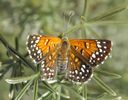Apodemia mormo langei
Classification
- Phylum: Arthropoda
- Subphylum: Hexapoda
- Class: Insecta
- Order: Lepidoptera
- Superfamily: Papilionoidea
- Family: Riodinidae
- Subfamily: Riodininae
- Tribe: Emesidini
- Genus: Apodemia
- Species: mormo
- Subspecies: langei
Pronunciation
How to pronounce Apodemia mormo langei: /ˌæpoʊˈdiːmiə ˈmɔːrmoʊ ˈlæŋɡi/
These audio files are automatically generated. While they are not always 100% accurate, they are a good starting point.
Images






Summary
Apodemia mormo langei is a localized subspecies of the Mormon metalmark butterfly, characterized by its unique coloration and strict habitat requirements, primarily associated with Eriogonum nudum. Conservation efforts are critical for its survival due to its rare and endangered status, influenced by habitat restrictions and human activity.
Physical Characteristics
Wingspan of 25–35 mm; males slightly smaller than females; distinct orange coloration toward the base of the hind wings; discal white spots may be replaced with orange; gray body with green eyes; black and white banded antennae.
Identification Tips
Look for the orange coloration on the hind wings and the distinctive discal spots; a presence of Eriogonum nudum in habitats may indicate A. m. langei.
Habitat
Dune habitats primarily in Contra Costa County, California; dry, arid regions with a high density of Eriogonum species; also found in sloping hillsides, gravelly deserts, and areas with soil disturbances.
Distribution
Primarily restricted to the Antioch Dunes National Wildlife Refuge in California; populations span western North America, from Sinola, Mexico to Southwestern Canada, with colonies in California, Utah, Arizona, New Mexico, and Washington; Canadian populations in British Columbia and Saskatchewan.
Diet
Larvae feed on various species of Eriogonum; adults mainly feed on the nectar of Eriogonum pauciflorum and occasionally rabbitbrush (Ericameria nauseosus).
Life Cycle
Univoltine; eggs laid in clusters; larvae emerge in winter, feed on host plants, and pupate in summer; adults emerge from July to September.
Reproduction
Mating occurs around three days into adult life; females may mate multiply; oviposition behavior varies between populations, with eggs laid in clusters or in rocky crevices.
Predators
Parasites include Trichogramma kaykai, a small parasitic wasp.
Conservation Status
Considered rare and endangered; Canadian populations listed as 'endangered' (British Columbia) and 'threatened' (Saskatchewan).
Ecosystem Role
Key player in the ecosystems where Eriogonum species thrive, acting as a pollinator during its adult phase and a part of the food web as larvae and adults.
Evolution
Evolutionary studies suggest ongoing investigations into subspecies and genetic diversity due to small isolated populations and distinct morphologies.
Similar Taxa
Tags
- Lepidoptera
- butterfly
- endangered species
- Riodinidae
- California